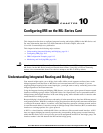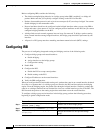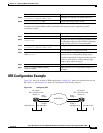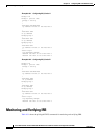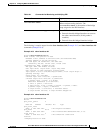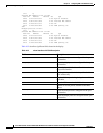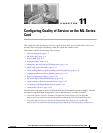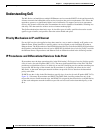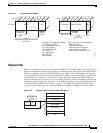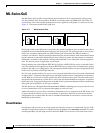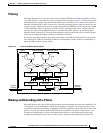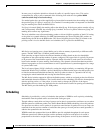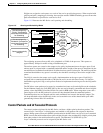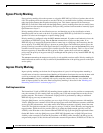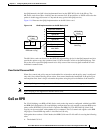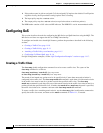
11-3
Cisco ONS 15310-CL and Cisco ONS 15310-MA Ethernet Card Software Feature and Configuration Guide R8.5
78-18133-01
Chapter 11 Configuring Quality of Service on the ML-Series Card
Understanding QoS
Figure 11-1 IP Precedence and DSCP
Ethernet CoS
Ethernet CoS refers to three bits within a four byte IEEE 802.1Q (VLAN) header used to indicate the
priority of the Ethernet frame as it passes through a switched network. The CoS bits in the IEEE 802.1Q
header are commonly referred to as the IEEE 802.1p bits. There are three CoS bits that provide eight
classes, matching the number delivered by IP precedence. In many real-world networks, a packet might
traverse both Layer 2 and Layer 3 domains. To maintain QoS across the network, the IP ToS can be
mapped to the Ethernet CoS and vice versa, for example, in linear or one-to-one mapping, because each
mechanism supports eight classes. Similarly, a set of DSCP values (64 classes) can be mapped into each
of the eight individual Ethernet CoS values. Figure 11-2 is an IEEE 802.1Q Ethernet frame, which
consists of a 2-byte Ethertype and a 2-byte tag (IEEE 802.1Q Tag) on the Ethernet protocol header.
Figure 11-2 Ethernet Frame and the CoS Bit (IEEE 802.1p)
96499
DS-Field
Class Selector
Codepoints
Currently
Unused
Differentiated Services Code Point
AFC 2474
DSCP CU
0
Bits
1234567
RFC 1122
RFC 1349
Must
be
zero
DTR-Bits
Bits (0-2): IP-Precedence Defined
111 (Network Control)
110 (Internetwork Control)
101 (CRITIC/ECP)
100 (Flash Override)
011 (Flash)
101 (Immediate)
001 (Priority)
000 (Routine)
Bits (3-6): Type of Service Defined
0000 (all normal)
1000 (minimize delay)
0100 (maximize throughput)
0010 (maximize reliability)
0001 (minimize monetary cost)
Precedence Type of Service MBZ
0Bits 1234567
96496
Destination Address6
Source Address6
Type=81002
Tag Control Information2
Type/Length2
MAC DATA
PAD
42~1500
FCS4
IEEE 802.1Q Tag
VLAN ID
CFICoS
IEEE 802.1p
(3 bits)



